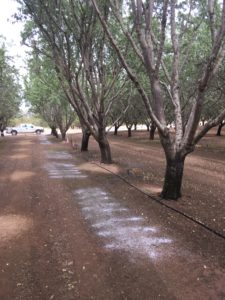
Written by David Doll (UCCE Merced) and Franz Niederholzer (UCCE Yuba-Sutter-Colusa)
Applications of nitrogen in the postharvest period have been promoted as a good farming practice.* Trees utilize nitrogen at this time to rebuild nitrogen stores and provide nutrients for bud development. Research from the Kern County nitrogen trials found that trees can absorb approximately 15% of annual nitrogen demand in the 8 weeks after harvest (30-45 lbs/acre, excluding application inefficiencies). This work was done in a highly productive orchard (3000+ lbs/acre) and applications were applied as multiple fertigation events through the entire year.
Fertilizer nitrogen applications should be made as soon as possible after harvest to allow the trees the most time to absorb fertilizer nitrogen before the leaves drop, when root nutrient uptake essentially stops. Whole almond tree nitrogen need after harvest is much less than in the spring (no shoot growth or crop), therefore fall fertilizer nitrogen needs are relatively minor compared with leaf out to hull split. Fall nitrogen fertilization need is further reduced by remobilization of leaf nitrogen into woody tissue storage as trees prepare to drop their leaves in November (if they are not burned off with zinc sulfate.)
Interestingly, recent research suggests that late postharvest fertilization (October) can be skipped if mid-July leaf nitrogen levels are adequate (over 2.5% nitrogen). This work by Franz Niederholzer conducted at the Nickels Soil Lab in Colusa County has found no negative impact on yields when skipping postharvest nitrogen applications within orchards over the past two years. In this trial, trees had mid-July leaf nitrogen values of 2.55% or greater. Trees receive 0 or 30 lbs/acre of postharvest nitrogen in mid October. Trees didn’t receive late zinc sulfate foliar spray and maintained leaves up to or through Thanksgiving. Over the past two years, there were no differences in yields between treatments that received postharvest nitrogen and the unfertilized control. This study suggests that trees that have adequate nitrogen levels (determined by summer leaf nitrogen value) have enough stored nitrogen to assist with bud and crop development until the next year’s leaf-out and subsequent in-season nitrogen applications. This research is being continued, with mid-September application timing.
By reducing postharvest nitrogen application, cultural costs and the risk of nitrate leaching are reduced. If mid-July leaf nitrogen levels are below 2.5%, postharvest nitrogen applications may assist with future yields. Later nitrogen applications (after mid-September), however, should be reduced.
*Current better management practices include split applications of nitrogen – essentially a 20-30-30-20 program that recommends these application amounts and timing:
- 20% of annual nitrogen budget by full leaf out (Feb-Mar);
- 30% of annual nitrogen budget between full leaf out and shell hardening (April);
- 30% of annual nitrogen budget between shell hardening and nut fill (May-early June);
- 20% of annual nitrogen budget between hull split and leaf drop (July-early November).
Influence of fall nitrogen rates on Nonpareil yield the next year. Data are not significantly different in any of the columns.
| Treatment
(Fall, 2015)* |
Summer leaf N 2015 levels (% dw) | 2016 (kernel lbs/acre) | Yield difference from 2015 to 2016 (kernel lbs/acre) |
| 0 lbs N | 2.56 | 2,568 | – 482 |
| 30 lbs N | 2.60 | 2,465 | – 384 |
| 60 lbs N | 2.69 | 2,570 | – 496 |
*All trees received 195 lbs N/acre and 190 lbs N/acre as UN32 between April and June in 2015 and 2016, respectively.

